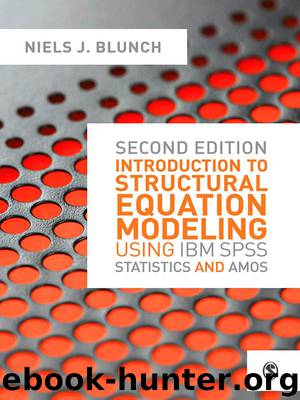Introduction to Structural Equation Modeling Using IBM SPSS Statistics and Amos by Blunch Niels J

Author:Blunch, Niels J. [Неизвестный]
Language: eng
Format: epub
Publisher: SAGE Publications
Published: 2012-11-08T22:00:00+00:00
We can see that only the budget functions are identified.
If these are the functions you are interested in, and equations 1 and 2 are only there to identify them, then of course that is OK and you can estimate functions 3 and 4 – but not using AMOS. Unfortunately, AMOS will not estimate part of a model. If just one parameter in a model is unidentified AMOS will give a warning and stop the calculation. Bass (partly) solved the identification problems by using two-stage least squares estimation – a limited information method not currently available in AMOS.
A warning
Recall the formulation of the error message in the output in Table 4.2:
The model is probably unidentified.
This formulation indicates that AMOS’s identification check is not totally safe.
When I estimated the Bass model in Figure 3 using Bass’s data I got no error message and AMOS estimated the total model even though it was only partially identified.
I must admit that this result was obtained using an earlier version of AMOS, and repeating the calculations using AMOS 19 gave the appropriate error message. However, as the formulation of the error message is still the same, it is only fair to warn the reader that he or she could run into the same problem.
If at all possible, you should examine the identification status of your model before you collect data, so that you can add the number of exogenous variables required to obtain identification.
It is possible to circumvent the warning and let AMOS try to fit a model that appears to be under-identified. However, this is usually not recommended – and for that reason I will not state the command!
A sufficient condition: the rank condition
As mentioned, the order condition is only necessary but not sufficient. The reason is that the variables introduced in order to obtain identification must be independent of each other. If we introduce a variable which covaries with another already in the model, the new one will to a larger or smaller degree repeat information that we already have.
An exact formulation of the (general) rank condition is beyond the scope of this book (but see e.g. Brown (1991) for a simple explanation) because it is based on matrix algebra, but fortunately it is rare in practice to find a model that meets the order condition but does not also meet the rank condition.
4 What Does Two-way Causation Really Mean?
In a model based on experimental data there is no doubt about the direction of the arrows: they depart from the manipulated variables, and it is absurd to think about letting them point in the opposite direction. In models based on non-experimental data you may sometimes have your doubts as to the causal direction. Unfortunately, this subject is rather poorly treated in the literature – but take a look at Davis (1985). However, some guidance can be found in the following two ‘rules’:
Cause is prior to effect.
Causes are often variables whose values are more stable than effects.
Download
This site does not store any files on its server. We only index and link to content provided by other sites. Please contact the content providers to delete copyright contents if any and email us, we'll remove relevant links or contents immediately.
| Biomathematics | Differential Equations |
| Game Theory | Graph Theory |
| Linear Programming | Probability & Statistics |
| Statistics | Stochastic Modeling |
| Vector Analysis |
Weapons of Math Destruction by Cathy O'Neil(5029)
Factfulness: Ten Reasons We're Wrong About the World – and Why Things Are Better Than You Think by Hans Rosling(4015)
Factfulness_Ten Reasons We're Wrong About the World_and Why Things Are Better Than You Think by Hans Rosling(2751)
Descartes' Error by Antonio Damasio(2728)
A Mind For Numbers: How to Excel at Math and Science (Even If You Flunked Algebra) by Barbara Oakley(2688)
TCP IP by Todd Lammle(2633)
Applied Predictive Modeling by Max Kuhn & Kjell Johnson(2474)
Fooled by Randomness: The Hidden Role of Chance in Life and in the Markets by Nassim Nicholas Taleb(2407)
The Book of Numbers by Peter Bentley(2400)
The Tyranny of Metrics by Jerry Z. Muller(2397)
The Great Unknown by Marcus du Sautoy(2180)
Once Upon an Algorithm by Martin Erwig(2142)
Easy Algebra Step-by-Step by Sandra Luna McCune(2110)
Practical Guide To Principal Component Methods in R (Multivariate Analysis Book 2) by Alboukadel Kassambara(2088)
Lady Luck by Kristen Ashley(2067)
Police Exams Prep 2018-2019 by Kaplan Test Prep(2028)
Linear Time-Invariant Systems, Behaviors and Modules by Ulrich Oberst & Martin Scheicher & Ingrid Scheicher(1980)
All Things Reconsidered by Bill Thompson III(1957)
Secrets of Creation, Volume 1: The Mystery of the Prime Numbers by Watkins Matthew(1858)
